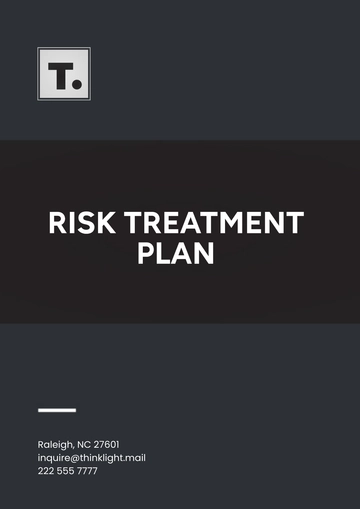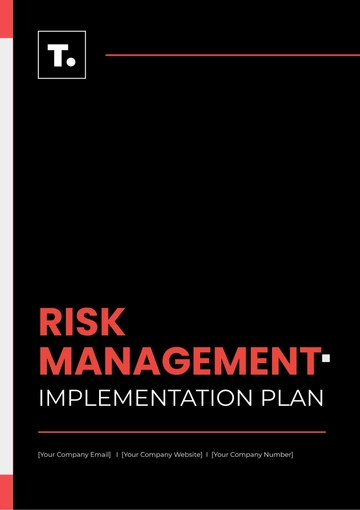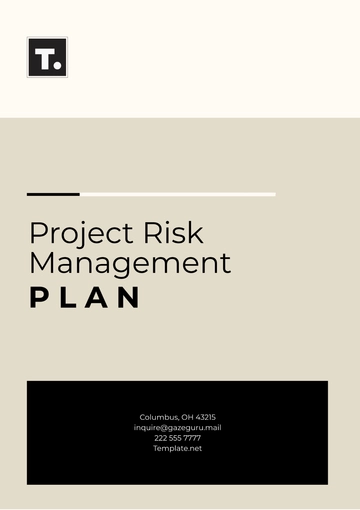Free Risk Department Annual Plan

Prepared by | Department | Date |
|---|---|---|
[Your Name] | [Your Department] | [Date] |
I. Executive Summary
This document provides a comprehensive overview of the Risk Department's annual plan, elucidating its core objectives and strategic initiatives.
[Your Company Name] specializes in providing cutting-edge risk management solutions, tailored specifically for technology firms. With a wealth of experience and expertise in the field, [Your Company Name] is committed to helping organizations proactively identify and mitigate potential risks to their operations.
The primary aim of this annual plan is to fortify organizational resilience by implementing proactive risk management strategies. Key objectives include enhancing risk assessment methodologies, strengthening risk identification processes, and fostering a culture of risk awareness across the organization.
II. Risk Assessment Methodology
This section details our rigorous methodology for assessing risks comprehensively and systematically.
Quantitative Analysis: Leveraging state-of-the-art analytics tools to quantify risks based on their probability and potential impact on the organization's objectives.
Qualitative Assessment: Evaluations of non-quantifiable risks through expert judgment, scenario analysis, and historical data review.
Risk Matrix: Dynamic risk matrix to prioritize identified risks based on their severity and likelihood of occurrence.
III. Risk Identification
Here, we elaborate on the process of identifying potential risks, covering internal and external factors.
Internal Factors: Evaluating risks related to organizational structure, processes, culture, and resource allocation to ensure comprehensive risk coverage.
External Factors: Analyzing industry trends, market conditions, regulatory landscapes, geopolitical events, and emerging technologies to anticipate external threats.
Stakeholder Input: Engaging key stakeholders through workshops, surveys, and interviews to gain valuable insights into potential risks and their impact.
IV. Risk Mitigation Strategies
This section elucidates the proactive strategies and actions devised to mitigate identified risks effectively.
Controls Implementation: Implementing robust control measures and safeguards to minimize the likelihood and impact of identified risks on organizational objectives.
Risk Transfer: Exploring options for transferring risks through insurance policies, contractual agreements, and strategic partnerships to mitigate financial exposures.
Contingency Planning: Develop comprehensive contingency plans and response strategies to manage unforeseen events and minimize disruption to business operations.
V. Risk Monitoring and Reporting
The Risk Department's approach to continuous monitoring and reporting of identified risks throughout the year is detailed in this section.
Monitoring Mechanisms: Proactive processes for ongoing risk monitoring, including the utilization of key risk indicators (KRIs) and early warning systems to detect emerging risks.
Reporting Framework: Defining the frequency, format, and channels for reporting risk updates to relevant stakeholders, ensuring transparency and accountability.
Escalation Procedures: Outlining clear procedures for escalating high-risk issues to senior management for timely review, decision-making, and resolution.
VI. Compliance and Regulatory Considerations
[Your Company Name]'s commitment to ensuring compliance with relevant laws, regulations, and industry standards.
Regulatory Updates: Abreast of changes in regulatory requirements and compliance obligations that may impact the organization's operations.
Audit Preparedness: Conduct regular audits and assessments to evaluate compliance with internal policies, external regulations, and industry best practices.
Training and Awareness: Comprehensive training programs and resources to employees to enhance awareness of compliance obligations and foster a culture of ethical conduct.
VII. Risk Culture and Awareness
Initiatives aimed at fostering a strong risk-aware culture within the organization are highlighted in this section.
Training Programs: Tailored training modules and workshops on risk management principles, practices, and tools for employees at all levels of the organization.
Communication Campaigns: Targeted awareness campaigns and initiatives to emphasize the importance of risk management and individual accountability in achieving organizational objectives.
Recognition and Incentives: Recognizing and rewarding employees who demonstrate proactive risk management behaviors and contribute to enhancing the organization's risk culture.
- 100% Customizable, free editor
- Access 1 Million+ Templates, photo’s & graphics
- Download or share as a template
- Click and replace photos, graphics, text, backgrounds
- Resize, crop, AI write & more
- Access advanced editor
Enhance and Discover the Risk Department Annual Plan Template from Template.net. Crafted for precision and efficiency, this editable and customizable template empowers risk management teams to streamline planning processes effortlessly. Seamlessly editable in our Ai Editor Tool, it ensures tailored strategies for risk mitigation. Elevate your risk management game with ease and precision.
You may also like
- Finance Plan
- Construction Plan
- Sales Plan
- Development Plan
- Career Plan
- Budget Plan
- HR Plan
- Education Plan
- Transition Plan
- Work Plan
- Training Plan
- Communication Plan
- Operation Plan
- Health And Safety Plan
- Strategy Plan
- Professional Development Plan
- Advertising Plan
- Risk Management Plan
- Restaurant Plan
- School Plan
- Nursing Home Patient Care Plan
- Nursing Care Plan
- Plan Event
- Startup Plan
- Social Media Plan
- Staffing Plan
- Annual Plan
- Content Plan
- Payment Plan
- Implementation Plan
- Hotel Plan
- Workout Plan
- Accounting Plan
- Campaign Plan
- Essay Plan
- 30 60 90 Day Plan
- Research Plan
- Recruitment Plan
- 90 Day Plan
- Quarterly Plan
- Emergency Plan
- 5 Year Plan
- Gym Plan
- Personal Plan
- IT and Software Plan
- Treatment Plan
- Real Estate Plan
- Law Firm Plan
- Healthcare Plan
- Improvement Plan
- Media Plan
- 5 Year Business Plan
- Learning Plan
- Marketing Campaign Plan
- Travel Agency Plan
- Cleaning Services Plan
- Interior Design Plan
- Performance Plan
- PR Plan
- Birth Plan
- Life Plan
- SEO Plan
- Disaster Recovery Plan
- Continuity Plan
- Launch Plan
- Legal Plan
- Behavior Plan
- Performance Improvement Plan
- Salon Plan
- Security Plan
- Security Management Plan
- Employee Development Plan
- Quality Plan
- Service Improvement Plan
- Growth Plan
- Incident Response Plan
- Basketball Plan
- Emergency Action Plan
- Product Launch Plan
- Spa Plan
- Employee Training Plan
- Data Analysis Plan
- Employee Action Plan
- Territory Plan
- Audit Plan
- Classroom Plan
- Activity Plan
- Parenting Plan
- Care Plan
- Project Execution Plan
- Exercise Plan
- Internship Plan
- Software Development Plan
- Continuous Improvement Plan
- Leave Plan
- 90 Day Sales Plan
- Advertising Agency Plan
- Employee Transition Plan
- Smart Action Plan
- Workplace Safety Plan
- Behavior Change Plan
- Contingency Plan
- Continuity of Operations Plan
- Health Plan
- Quality Control Plan
- Self Plan
- Sports Development Plan
- Change Management Plan
- Ecommerce Plan
- Personal Financial Plan
- Process Improvement Plan
- 30-60-90 Day Sales Plan
- Crisis Management Plan
- Engagement Plan
- Execution Plan
- Pandemic Plan
- Quality Assurance Plan
- Service Continuity Plan
- Agile Project Plan
- Fundraising Plan
- Job Transition Plan
- Asset Maintenance Plan
- Maintenance Plan
- Software Test Plan
- Staff Training and Development Plan
- 3 Year Plan
- Brand Activation Plan
- Release Plan
- Resource Plan
- Risk Mitigation Plan
- Teacher Plan
- 30 60 90 Day Plan for New Manager
- Food Safety Plan
- Food Truck Plan
- Hiring Plan
- Quality Management Plan
- Wellness Plan
- Behavior Intervention Plan
- Bonus Plan
- Investment Plan
- Maternity Leave Plan
- Pandemic Response Plan
- Succession Planning
- Coaching Plan
- Configuration Management Plan
- Remote Work Plan
- Self Care Plan
- Teaching Plan
- 100-Day Plan
- HACCP Plan
- Student Plan
- Sustainability Plan
- 30 60 90 Day Plan for Interview
- Access Plan
- Site Specific Safety Plan





























